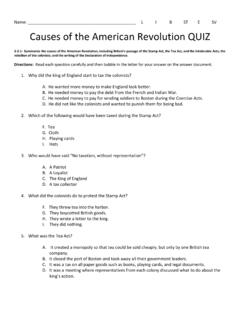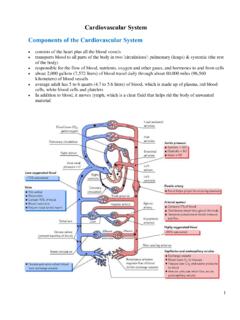Transcription of Study Guide Answers: Blood and the Cardiovascular System
1 November 04, 2015 Study Guide Answers: Blood and the Cardiovascular SystemNovember 04, 2015A) Composition and Functions of Blood ~ 6 Liters45% Formed Elements55% Plasma Plasma is comprised of:proteinsnutrients mineralssaltshormonesImportance =It serves as a transport matrix for the bodyand distributes body heat.(albumin)antibodiesgases90% the composition of plasma and discuss its importance in the the composition and volume of whole Blood . November 04, 20153) List the cell types making up the formed elements and describe the major functions of each type PART IErythrocytes!
2 (Red Blood Cells or RBCs)preferred term biconcave disc shape contain hemoglobin, binds O2 & CO2 has no nucleus or organelles 100 120 day life span rate of production is controlled by the hormone erythropoietin low oxygen prompts increase in RBC production November 04, 2015 Eosinophil has small granules and often dyes red usually seen in higher numbers when an individual has parasitesGranularAgranularBasophil highly granular the least common WBC ( ) secretes histamine creates inflammation in allergic reactionsLymphocytes produce antibodies image is mostly nucleusMonocytes the largest of the white Blood cells.
3 Characteristic U shaped nuclei become macrophages Platelets (Thrombocytes): form from megakaryocytes involved in Blood clotting Made in bone marrow(red) count = 250 500,000/mm3 Neutrophils often look like they have multiple nuclei makes up 60% of WBCs granules are very small, contain digestive enzymes phagocytize & destroy bacteria First cells to respond to infection secrete antibacterial chemicals3) List the cell types making up the formed elements and describe the major functions of each type (Part II)Leukocytes or White Blood Cells (WBCs)
4 Preferred termdefense + immunityNovember 04, 2015basophilthrombocyteneutrophileosinop hillymphocyteserthyrocytesmonocyteNovemb er 04, 20154) Hemocytoblast the stem cell that is the precursor for all Blood cells found in red bone marrow Stoppage of Blood flowInhibit:1. platelet deficiency inhibits Blood clotting2. deficit of clotting factors (proteins)2. sterile gauze to provide a place for platelets to adhere1. applying pressure to trigger the release of binding enzymes/proteinsEnhance:B)Hemostasis 2. Name some factors that may inhibit or enhance the Blood clotting process.
5 1. What is hemostasis? November 04, 2015C) Blood Groups and Transfusions 1. Describe the ABO and Rh Blood groups. ABO GroupsThere are 4 Blood types a) A has A antigens b) B has B antigens c) AB has A & B antigens d) O has no antigens 2) you cannot receive Blood that has an antigen you don't already have 3) if a mismatch occurs, agglutination (clumping of the Blood ) can occur 4) O universal donor type because no antigen's on RBC surface 5) AB universal recipient type November 04, 2015Rh factors a) a variety of antigens that may or may not be present in your Blood b)
6 If Rh is present, you have Rh+ Blood c) if it is absent, you have Rh Blood d) With the first pregnancy, an Rh mother carries an Rh+ baby with no problems. e) Danger can occur when an Rh mother is carrying her SECOND Rh+ baby!f) Mother's immune System will make anti Rh antibodies unless she receives RhoGAM after the first birth to block immune response. i) antibodies in the mother's Blood can get into the baby's System and damage the baby ii) transfusions of the baby's Blood are required to prevent anemia and hypoxia iii) if untreated, brain damage and even death may occur November 04, 2015 November 04, 2015 November 04, 20152.
7 Explain the basis for a transfusion reaction. Erythrocytes mixed with an antibody directed against their Blood type will cause an immune attach to the newly transfused cells and agglutination occurs. Agglutination is clumping that occurs because the Blood has reacted with a certain antibody. It indicates the Blood is not compatible with Blood containing that kind of antibody. If the Blood does not agglutinate, it indicates that the Blood does not have the antigens for that 04, 2015 Pulmonary edema (fluid in the lungs) is an example of a transfusion 04, 2015D) Homeostatic Imbalances(see the homeostatic imbalances document)November 04, 2015 Location Mediastinum (in the thorax, between the lungs) Superior to the diaphragm The pointed apex is directed toward your left hipA)Describe the location of the heart in the body and identify its major anatomical areas on an appropriate model or diagram.
8 November 04, 2015 The Pathway of Blood to and from the Heart Deoxygenated Blood from the body enters through the superior and inferior vena cava into the right atrium. It passes through the tricuspid valve into the right ventricle. The Blood leaves through the pulmonary semi lunar valves and flows into the pulmonary trunk into the pulmonary artery. The Blood flows to the lungs, where CO2 is dropped off and O2 is acquired. The oxygenated Blood re enters the heart through the pulmonary veins. The Blood flows into the left atrium, then through the bicuspid (mitral) valve.
9 The Blood enters the left ventricle, where it is pumped out through the aortic semilunar valve. The Blood enters the aortic arch and then the aorta, where it is sent out into the )Trace the pathway of Blood through the heart. November 04, 20152)Compare the pulmonary and systemic circuits. Pulmonary: Heart Lungs heartSystemic: Heart Body heartCO2 outO2 inO2 outCO2 into bloodThe pulmonary circuit starts in the right ventricle with the deoxygenated Blood that is being pumped to the lungs and ends in the left systemic circuit starts in the left ventricle with the oxygenated Blood that is pumped out to the body, and ends in the right 04, 2015AV or Atrioventricular Valves Flexible barriers, prevent backward flow of Blood between the atria and ventricles Consist of fibrous connective tissue flaps attached by chordae tendinae.
10 Papillary muscles pull the chordae tendinae to keep the valves shut. Semilunar Valves flexible barriers, prevent backward flow of Blood between the Blood vessels and the ventricles. backward flow of Blood fills the half moon (semilunar) valve cups, holding it Explain the operation of the heart valvesBicuspid (Mitral) Valve Tricuspid Valve Pulmonary Semilunar Valve Aortic Semilunar Valve November 04, 2015pulmonary semi lunar valveaortic semi lunar valveNovember 04, 2015B. Name the elements of the intrinsic conduction System of the heart and describe the pathway of impulses through this System .





